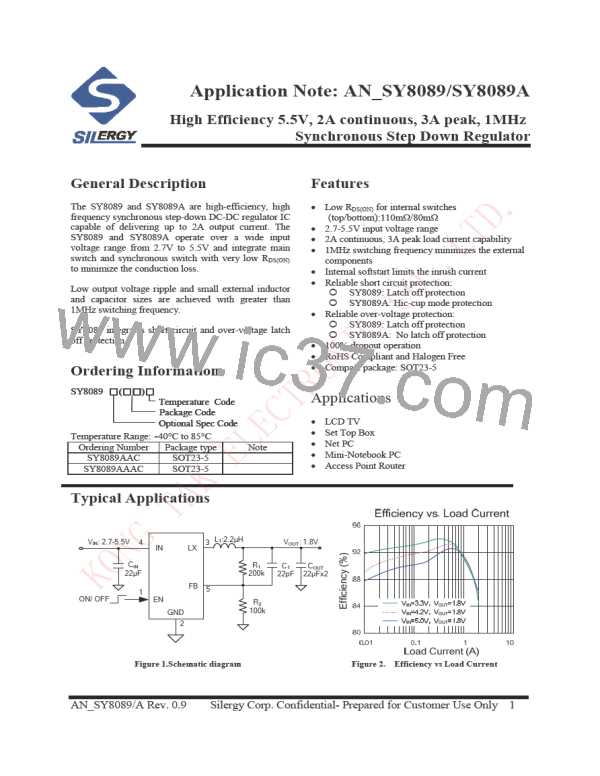SY8089/8089A
of inductance can be slightly off the calculation value
without significantly impacting the performance.
2) The saturation current rating of the inductor must
be selected to be greater than the peak inductor
current under full load conditions.
Layout Design:
The layout design of SY8089 regulator is relatively
simple. For the best efficiency and minimum noise
problems, we should place the following components
close to the IC: CIN, L, R1 and R2.
1) It is desirable to maximize the PCB copper area
connecting to GND pin to achieve the best thermal and
noise performance. If the board space allowed, a
ground plane is highly desirable.
2) CIN must be close to Pins IN and GND. The loop
area formed by CIN and GND must be minimized.
V
OUT(1-VOUT/VIN
,
MAX
)
ISAT
,
MIN > IOUT
,
MAX
+
2 FSW
L
3) The DCR of the inductor and the core loss at the
switching frequency must be low enough to
achieve the desired efficiency requirement. It is
desirable to choose an inductor with DCR<50mΩ
to achieve a good overall efficiency.
3) The PCB copper area associated with LX pin must
be minimized to avoid the potential noise problem.
Enable Operation
4) The components R1, R2, and the trace connecting to
the FB pin must NOT be adjacent to the LX net on the
PCB layout to avoid the noise problem.
Pulling the EN pin low (<0.4V) will shut down the
device. During shut down mode, the SY8089 shutdown
current drops to lower than 0.1uA. Driving the EN pin
high (>1.5V) will turn on the IC again.
5) If the system chip interfacing with the EN pin has a
high impedance state at shutdown mode and the IN pin
is connected directly to a power source such as a LiIon
battery, it is desirable to add a pull down 1MΩ resistor
between the EN and GND pins to prevent the noise
from falsely turning on the regulator at shutdown mode.
Load Transient Considerations:
The SY8089 regulator IC integrates the compensation
components to achieve good stability and fast transient
responses. In some applications, adding a 22pF ceramic
cap in parallel with R1 may further speed up the load
transient responses and is thus recommended for
applications with large load transient step requirements.
AN_SY8089/A Rev. 0.9
Silergy Corp. Confidential- Prepared for Customer Use Only 9
